Events in our lives happen in a sequence in
time, but in their significance to
ourselves they find their own order . . . the
continuous thread of revelation.
—Eudora Welty, One Writer’s Beginnings
Writers find real life images to compare what happens as they mold life events into stories:
- To fabric (thread and weaving)
- To clay (molding a lump into a recognizable form)
- To construction (building a house from the foundation up)
Finding the right shape for telling our story is a critical step in the memoir writing process. Writers call it the narrative arc.
Paging through a photo album of my trip to Switzerland, I have found another metaphor for structuring my memoir: Contours of the Swiss Alps
Climbing the Alps fits with the theme and title of Journey of Memoir by Linda Joy Myers and Brooke Warner. “One of the most challenging aspects of writing a memoir, which of course is based on true and real events in your life, is to create a plot out of what happened.” (104)
I know my life story. I don’t have to make up events and characters. Through trial and error, I have decided that my theme is the quest for my true self as a sheltered Mennonite girl growing up in Lancaster County, Pennsylvania.
Still, I have to mold my tale into a story of transformation, one that will grip readers’ imagination and keep them turning the pages.
* * *
Aristotle affirms that every story needs a beginning, a middle, and an end: Act One, Act Two, Act Three.
Stories that intrigue have conflict too. For example, when you saw a play like Our Town or Macbeth, you were transported into another world through exposition, rising action (the story builds), a crisis, a climax, and finally a resolution.

Crisis at midpoint (all seems to be lost) Climax (major conflict narrator must resolve) Conclusion (epiphany – Ah, so that’s it!)
My 7 Steps . . .
- I created a timeline of vivid memories in my life. This is how I hoped to arrive at my turning points, moments of significant change. As I drew, I thought in terms of chronology. What is my first memory? What stands out in elementary school? What family events pop up? Who looms large as a mentor? Answers to these questions could become turning points, I believed.
- Then I thought about scenes. On colored stickies I randomly wrote phrases that came to mind. For example: The phrase “Daddy yodeling” could turn into a scene about my sisters and me taking turns singing with Daddy at the piano, relating to the impact of music upon my formative years.
3. Next I gathered random scenes into a sensible order. Writers choose scenes based on how well they relate to their theme, the message of their memoir. For example, a theme can be traveling and what you learned on the journey, recovering from a challenging situation like an illness or abuse, or the struggles of becoming a chef. My own theme can be stated as a question: How can a girl from a sheltered and restrictive Mennonite culture find her place in an emerging new life?
A memoir is not an autobiography. I couldn’t include every detail of my entire life. I selected only those scenes that related to my theme. I write about this in a previous post.
- Sometimes I felt stuck. Fatigue sets in on a long climb. Air is more rare as one moves into the higher altitudes (Alp-titude in Swiss terms). Sometimes I felt faint-hearted.
- I constructed a narrative arc composed of scenes relating to my theme. A narrative arc can take several forms: curvy like a hill or jagged like the Swiss Alps.
The core of mine turned into an upside-down V-shape, rather like a peak in the Swiss Alps
The sticky notes make it possible for me to move ideas around easily. In fact, I’ve moved some notes into a different order since the photo was taken.
6. I’ve printed out copies of drafts. As I’ve progressed, I’ve stored manuscripts in labeled folders on my computer desktop. But I’ve also printed out copies of my drafts from my laptop because I find it helpful to touch the pages and make marginal notes in colored ink. Pages in the binders feel book-like, real.
7. I try to overlook messiness in my work space. Generally, I’m a neatnik, but worries about order, except in my writing, distract from my creative process.
So, that’s where I am now!
I began with an impulse to tell my story which progressed from
Journals –> Blog posts –> Memoir Drafts
At the moment, I’m in the muddy middle, aiming to complete the journey across the Alpine-scape of memoir.
More to come . . .
How about you?
Have you made a similar journey with memoir? How would you chart your narrative arc?
Coming next: Moments of Discovery, a Bubble, a Dome, a Mirror

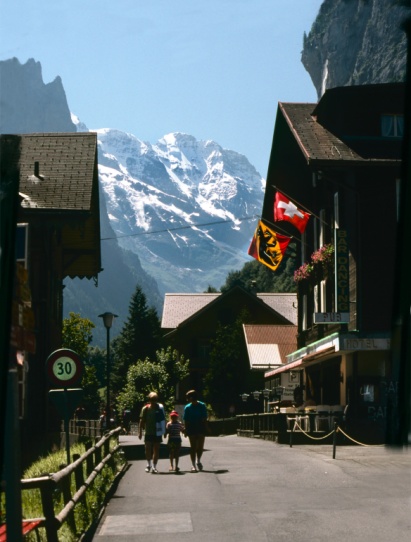
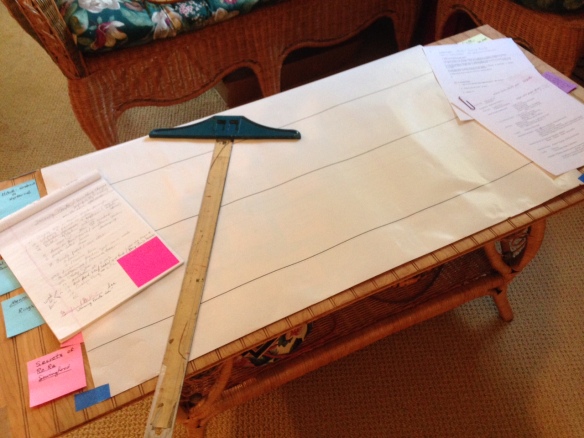
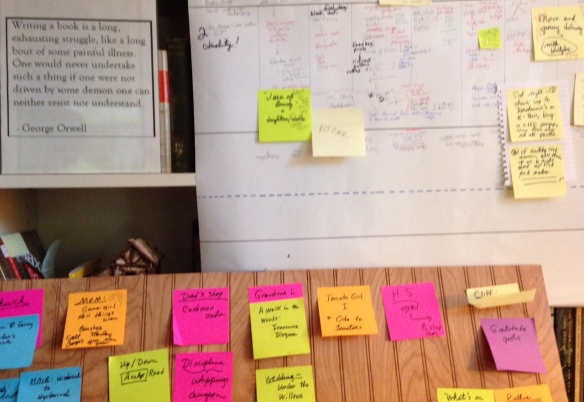

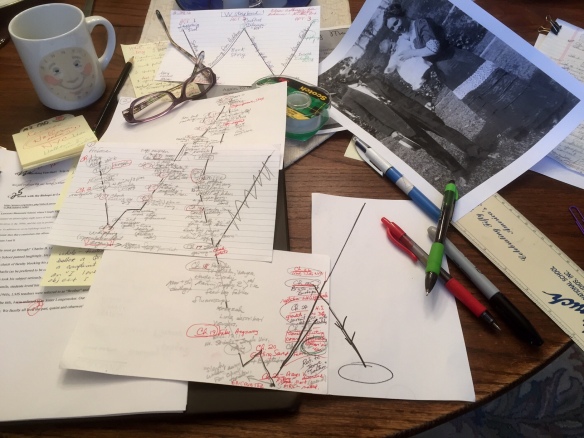
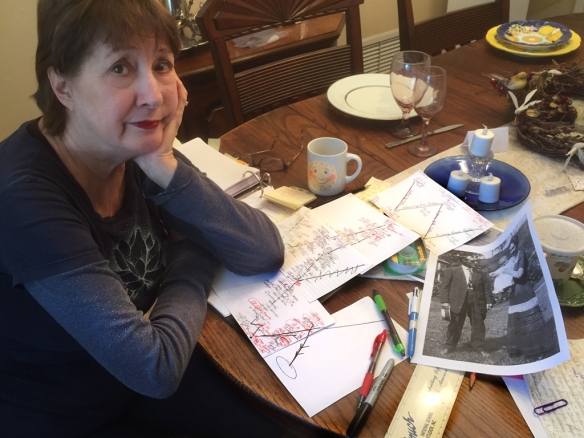
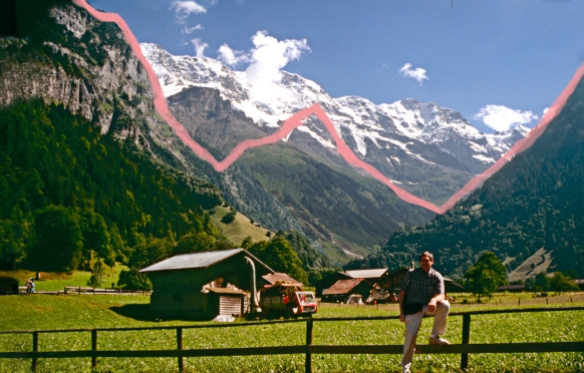



Good morning, Marian. I\’m happy to see the Swiss Alps made it into a post!
I enjoyed seeing your work and workspace. What you label messiness is nothing compared to mine. I admire your thoroughness and organization.
My cats would have so much fun with those sticky notes. 🙂
Kitty cats would distract me, but apparently they serve as your muses. Whatever works, I say. Remember Robert Herrick? \”Fine distraction\” and \”wild civility\” is more bewitching than when \”art / Is too precise in every part.\”
Getting up early works for you too. So encouraging to meet you here every Wednesday morning. Thank you, Merril.
Oh, the cats are definitely distractions at times! Thank you for the Herrick reference. I did not remember the lines, although when I looked it up, I remembered the poem. (I think he\’s talking about something else.);) But I shall embrace my lack of being too precise.
He IS talking mostly about the allure of women, but the idea of disorder fit here, well, sort of . . .
You are a precise thinker, that\’s what counts.
I can so relate to the photo of you with the sad face and the scribbled mess covering the table. That could be me, Marian. 🙂 Although I\’m not writing a memoir, I love to use florescent post-its and index cards to plot out my stories. Wishing you the best! Thanks for sharing your photos, they\’re beautiful.
What amazes me most about you is that you have a full-time job and write award-winning stories at night and on weekend. Best wishes as you persevere with your novel. I can\’t wait to get my hands on it, Jill.
Thank you, Marian…it\’s a juggling act. I can\’t wait to read your memoir. 🙂
This is so incredibly helpful, as I think about what\’s down the pike for me–or should I say up the Alp? The visuals you provide make it graphic. And an unsmiling but still lovely Marian? What\’s that? Great post up my alley. My first memoir of a year in voluntary service in Kentucky was more of a \”let\’s put in everything outstanding or unusual that happened that year\” kind of book. With my 2nd, about my junior year in Spain, it was part travelogue but also worked with the title\’s underlying theme of \”Departure\” and I did more careful choosing of what to include, what to leave out. Thanks for opening up your process.
Apparently as author/editor your process involves both the visual and the verbal too. And as you point out, there are many ways to write memoir. One author I know, Tracy Lee Karner, combined memoir with a New England travel guide.
Thank you for letting me know this post resonated with you, Melodie.
Looking forward to the finished product !
Sent from my iPhone
Thanks, Pat. I need a cheering section and I\’m seeing your enthusiastic smile right there in the middle.
Marian, this is a such a rich and helpful post. You have captured the essence of memoir writing…a jagged journey filled with surprises, self-discovery and yes, agony–a bit like mountain climbing –(love the photo of you and can relate!) I can see you are making wonderful progress and are well on your way. I will be standing in line, along with your many fans, ready to hold your memoir in my hands. Brava!
Ah, my encouraging side-kick again. I am so glad we could connect via Skype in Virginia for a short while, Kathy. We felt your spirit with us on the hike, with the ponies, and around the table. Yes, surprises, self-discovery and agony – let\’s get on with it!
This was a wonderful inside look at your writing process. Love the sticky notes everywhere. I used to do that too, until I started using Scrivener. Having to stick to a theme and not get side tracked would be my greatest challenge. You\’ve done a wonderful job and spent the time and effort to get it done right. I wish you much success with this project.
I have the Scrivener software, unused, on my desktop. I\’m sure it would be helpful, but I find the paper route more to my style maybe because I\’m tactile, maybe too because I\’m old-fashioned.
Thanks for the good wishes here, Susan. You are one ambitious trail-blazer!
It appears you have put a lot of thought into this Marian. I think that writing a memoir would be more difficult than fiction. By following your blog I can see you have great material. I wish you the best of luck with this project! I love the Swiss Alps analogy BTW.
You have been writing fiction effectively so long that switching to another genre may appear more difficult. Yet the research you put into each book has the effect of non-fiction – stories sounding true. Come to think of it, truth is every writer\’s goal, at least it\’s mine. Thank you for the good wishes and noticing the metaphor.
Once again you have amazed me.You are such a great writer and very organized. I now know at this point in my life I could not do this. My life has so many distractions kids grandkids husband church and now soon to open a cafe. Oh, my gosh what am I thinking. Always changing. One day my life will slow down and I will make time. In the interim I will enjoy your journey and learn from it. Love the pictures. Thank you. Still in California. Need to call you to tell you of this journey. Lol.
Gloria
To every thing there is a season. Right now you are in the season of making memories and obviously enjoying the moments. Mom would love to know about your new ventures; I like to think she does.
I would welcome your call, Gloria. Safe travels!
Great analogy, Marian. Apparently our shared Swiss roots have inspired both of us, although I would never have thought of narrative arc when I looked at the peaks. You are so imaginative.
I thought I remembered an old post on storyboarding. Sure enough, I found it. I definitely have some peaks in my picture also. You\’ll have to click to see the photo. (Old posts sometimes have glitches in them.) http://www.shirleyshowalter.com/are-you-a-pantser-or-a-plotter-approaches-to-memoir-writing-and-life/
As for discouragement, let me offer this word of comfort. The time you spend on plotting the structure will not be wasted. My own critique of my work is that my structure, despite the storyboard, was too episodic. Keep working on the tension and the obstacles. Like any mountain climber, you will enjoy the peak more when you have really worked for it.
We captured photos of these Swiss Alps in 1997, and we didn\’t climb them either. As I recall we photographed the Schilthorn, our heads in the clouds, when we got off a lift.
I clicked on your post again though it is still vivid in my memory. I remember too the 2014 yearly planner, a link that still works! Your encouragement means the world to me as I observe you climbing a different mountain in a new phase.
Marian — I absolutely love the \”faint-hearted\” photo of you! What an incredible adventure—a Swiss Alps one, at that—you\’re on! I can hardly wait to have the finished product in my hands!
Like other commenters, your enthusiasm keeps me going toward that \”finished product.\” You first though, a reality happening in a matter of months. Woo-hoo!
Wow–you are truly a Woman with a Plan; thanks for sharing your writing strategies!
Well, when I compare my plan with my actual writing, they don\’t quite match. (I\’ll resist putting a frowny face here.) Par for the course I guess.
Thanks for the comment here and for sharing Sage and your love of country on your own posts.
Oh, the woes of the muddy middle, Marian – I love/hate \’em!
Great photos. The one of you at your work table, the expression on your face, is priceless. It\’s fun seeing your process. Yours looks messy/organized, like mine. I\’d pity anybody who tried to come in and try and figure out what I was up to if I suddenly disappeared. heehee!
Keep going, Mirian – put your waders on and slog! =)
Thank you, book lover and story teller. Like you remind me on your about page, I wish to create characters who would be missed when the tale ends. At the moment, just getting the scenes in some semblance of order seems a monumental task. I believe we must be indeed kindred spirits in our work habits.
I so appreciate the comfort (and the prod) in your posting today, Cynthia. 😉
Thanks for sharing your creativeness with us. You remind me of David Brooks. a columnist for New York Times, an author, and professor at Yale U. He was on the Charlie Rose Show the other night and among other things, was explaining to Charlie how he writes. David writes notes to himself all the time. When he\’s ready to begin writing he makes piles of papers on the floor…14 piles of research and his notes. So…it works for David Brooks and it looks like it works for you! 🙂
David Brooks\’ method sounds more random (and experienced) than mine. I too admire his writing.
I\’ve heard of writers that are computer literate, but use legal-size tablets and a pen or pencil because they\’ve written successfully this way for so long. Why change when the magic happens the tried and true method. Thanks for the tip here. I may try to look his interview up on the Charlie Rose website.
I feel like I\’m on the journey with a pilgrim here, and I really do feel the progress as well. Christian, (famous in Pilgrim\’s Progress) chose \”Hope\” as his main companion, and he found fairly quickly that short cuts did not get him to his destination any faster. So, I\’m happy you include the mopey, lag times in your process. I\’m looking forward to your memoir, and I hope you keep on keeping on.
Ah, Dolores, I view you as a fellow pilgrim with Hope, our companion. I know you\’ve done some research and are embarking on memoir too – may be farther along than I realize. More power to you, and thanks for stopping by. 🙂
Those who can, Do AND Teach. You are a wonderful teacher, Marian. Well done! 🙂
Like you, Marylin, I\’ll never not be a teacher. It\’s in our blood – in our DNA for sure. I\’m glad you found this helpful. I\’m sure you use some of the same techniques as writing coach.
That\’s a wonderful idea and great analogy, Marian! I fear my life story would be more of a rollercoaster with dangerous spins and turns and some bits are best forgotten about! Best of luck with your memoirs. 👍
Readers love stories with dangerous spins and turns, even sad/bad bits. As a writer you get to choose. Thank you for the good wishes, Fatima.
That\’s very true: it wouldn\’t be much of a story if everything worked according to plan and no hitches!
😉 Sort of like reporting all the cats that didn\’t get lost today – ha!
Thanks for sharing your writing process with us Marian. I\’m always interested to see how other memoir writers like to organize their memoir writing, I see you\’re a fan of the post-it-note, my favourite! It seems as though your book is coming along!
Also remember that it\’s imperative to print out your book for pre edits. The eye catches more on paper than on the computer. 🙂
What you say is so true. I wonder if the eye catches more on paper than on the computer because we are digital immigrants, not digital natives like the millennials. As you see above, I\’m assembling binders filled with pages, pages. Thanks for the encouragement once again, Debby.
Anytime Marian. I\’m around if you need me. 🙂
😉
Hi Marian,
I\’m so happy to find your blog this afternoon. I appreciate that you are engaging the logic of the narrative arc – including the ruler, graphs, and charts, and the imagination – inspired by photographs, colored sticky notes, and the feel of paper. I look forward to reading more about your path through journaling, blogging, memoir drafts, and onto holding a book in your hands!
Kathleen
Thank you for your interest, Kathleen. In a guest post a few years ago, I wrote about my first year blogging experience which began in 2013: http://krpooler.com/getting-ideas-for-blog-posts/a-memoir-writers-first-year-in-blogging-adventure-by-marian-beaman
I\’m not sure that imagination is the opposite of logic, but I do know that writing requires accessing both. I appreciate your following my blog today and then leaving a comment here – so encouraging.
I did not mean to imply that imagination is the opposite of logic. Yes, we need access to both sides of our brain to be effective. I\’m intrigued that you so intentionally choose to use both in your writing process. Thank you again for sharing your process here!
Actually, I was searching for a word that would express the opposite of logic and came up with \”imagination,\” meaning of course trying to access both brain hemispheres. There may be a better word choice.
One of the things I like most about blogging is meeting other authors and forming a connection. So pleased to meet you here. 🙂
I\’m at the blogging stage, but I do eventually hope to get to the memoir writing. Time is running out on me though!
Ah, Elfrieda, you have made a great beginning. Now in my mid-seventies, I recognize that feeling of time running out but I try to resist it. Most of my online writing friends, much younger, have already published memoirs and novels. Thus, I keep on my desktop the hopeful reminder: \”Never give up on a dream just because of the time it will take to accomplish it. The time will pass anyway.\” (Earl Nightingale)
I am late by days …I ve been getting over an Easter visit …don\’t ask …and then my darling I forgot you …yes there it\’s out… and then your lovely face come in to view …how can I possibly forget you .
Wow have you got yourself in a tangle …go girl , leave your girl cave and go somewhere that gives you peace , the woods , the park , the beach …preferably somewhere in nature …and breath . Then go back to the girl cave and everything will fall into place .
I can not wait for you to have this book published . Isn\’t it exciting about Laurie \’s book out in the autumn ? Take care girl and …breath .
Oh by the way you think that is messy …no way 😊
I\’m taking your advice and \”leaving my books\” as Wordsworth suggests: This morning sitting on a grassy field watching grandson Curtis play soccer and then bringing him and Ian home for a movie and pizza. Maybe even toss popcorn into the air. Today is a day for play.
Yes, I too am waiting with bated breath for Laurie\’s book. It comes out in November. Mine – in due time! You are such a ball of encouragement, Cherry. Hugs to you for that!
Wow🎈🎈🎈 two new books on my bookshelf written by my two favourite online ladies …can\’t be bad .
Hope you came back refreshed after your day out …hugs back 😊
Cherryx
Wow two new books from my favourite online ladies .🎈🎈🎈
Hope you felt refreshed from your day out .
Hugs back😊
Love the way you compare your writing to the Alps!
In all of your travels, you must have seen them too. I\’m glad you can relate to the metaphor. Thank you, Fiona.
Incidentally, I loved how your post with rainbows on the drier coincided with my our drier break-down. It\’s fixed and I\’m using it now, as it churns our dry clothes, round rainbows sparking from the drier window.
Marion, I\’m shocked by your messy desk–and it makes me so happy because it looks like my desk and the table behind my desk when a project is cooking on the front burner. You are deep into the groove. Long before I imagined writing a memoir, I wrote the stories that spilled out of my bleeding heart with no thought about what I would do with them later. I then created the narrative from small pieces that already had their own beginnings and endings. I had to chop many of those and use the middle. Many stories were not used–for the sake of the narrative–and some of those became blogs.
I\’ve looked through many old comments here to find where you told me about Donald Hall\’s book \’The Best Day The Worst Day.\’ It was you, wasn\’t it? I didn\’t make that up, did I? Maybe you made that comment on my blog. In any case, I read it. It was both wonderful and horrible. He took me right down to the ER visits and cleaning out the ports. He reminded of the way the cancer world devoured everything. Talk about a tumultuous narrative arc. I\’m glad I read it–and from there I needed a novel. I want you to know that when you mention a book, I check into it. Keep mentioning, please. This book was important since I loved Jane Kenyon\’s \”Otherwise.\”
No use white-washing the truth, which sometimes boils over on the front burner, making a mess. Out of chaos can come order. Eh?
I have a feeling some of what I\’ve written may fall by the wayside. In fact, I know it will, but it\’s so hard to let go of our little darlings.
Yes, I\’m the one who suggested Donald Hall\’s books – also Jan Kenyon\’s. I made each of them a member of the family for a while, it seemed. Their home in NH reminds me a little of yours in Ithaca.
I just finished reading Daniel Klein\’s Travels with Epicurus today. Though philosophical and poignant, it\’s not heart-wrenching, and provides food for thought for people like us in our seventies. Besides, it\’s short (172 pages) and feels like a vacation along the Aegean, sort of. No obligation to read this, but it was a nice change of pace for me. I did review it on Riffle books and Goodreads.
I had only read \”Otherwise\” by Jane Kenyon (actually, it was read to me), but didn\’t remember the name of the poet. Thank you for making connections. As Donald Hall wrote–and I paraphrase–Jane Kenyon was first introduced as the wife of Donald Hall, but, in time, Hall was introduced as the husband of Jane Kenyon. I love many of her poems and will keep exploring.
I forgot to mention that I am honored when you say, \”I want you to know that when you mention a book, I check into it.\” Whether the book becomes a thumbs up/down for you is a personal decision. Comments like this make me feel like we are having a real conversation, which will become even more \”real\” when I finally meet me in person which is bound to happen. Thanks for your book suggestions too, Elaine!
You\’ve certainly done a lot of preliminary work, Marian! It will make your story much stronger, I\’m sure.
Do you take notice when a certain synchronicity crosses your path? It\’s been happening a lot to me lately. Your post embodied what I had just decided to do: my 2nd novel is 2/3rds done, and to clarify \”where my story is going,\” I just decided a few days ago to use sticky notes (with color coding) on my office wall to track the arcs of my two main characters, using the plot turns I\’ve created in my story. So you and I are definitely in sync! I want to do with this for both characters because I\’ve created dual protagonists and I want to make sure one character doesn\’t get more emphasis/spotlight in the story than the other.
I liked the way you showed your own story\’s arc relative to its own plot turns and tensions. I hadn\’t thought of doing that. It honors your own first draft and your own unique story, rather than trying to force your story into what the narrative arc \”is supposed to be\” according to the experts, i.e. the Narrative Arc diagram you shared.
Thanks!
Narative arcs with dual protagonists: that blows my mind. This is my first rodeo, so to speak, so my arc will be much simpler.
At the moment, my diagrams and charts here seem much more organized than the reality I find eviewing my draft. I wonder whether other writers feel the same disparity. Maybe that\’s why this writing stage is called the muddle middle.
I\’m heartened by the synchronicity you refer to. I was privy to some of this magic when a writer/editor at a retreat I recently met offered to critique a chapter – not once but twice. Maybe it was three times. Eventually I\’ll need to hire a developmental editor.
Thank you for the support I read both overtly and expressed between the lines here. Thank you,Kas!
What a process! Memoir writing is so different than other types of writing. The more I learn about it, the more those differences stand out. What a journey for you 🙂
Golly – Gee, Diana! Thanks for reading and commenting here. Indeed, memoir writing is so different from other genres. At the moment, I would say \”Writing makes me hungry.\” After 2-3 hours of writing/reading aloud (ha!) I feel ravenous. This, after eating a high-protein breakfast. I wonder whether other writers experience something similar.
Good question. I tend to get so absorbed that I don\’t break to eat and drink. I became seriously dehydrated last year and developed heart problems!! Now I have to set the timer to remind myself to drink water. So, I say, give yourself a pat on the back for taking care of yourself 😀
Well, I\’ll give myself a pat on the back, but I\’m rather fidgety by nature. That may explain my eating/drinking often enough. Or, maybe I don\’t descend completely \”into the zone.\” Either way, \’tis a mystery.
I find learning about other writers\’ processes endlessly fascinating. Thanks for sharing your anecdote here.
Marian, somehow in the midst of my pain I missed this post when it was originally posted. This morning I received a note from WordPress that you had \”liked\” my new post, and I saw the title of this one and immediately came to check it out.
First, thank you for the rich imagery and metaphorical comparison you have made for the narrative arc and the Swiss Alps. As I begin to rework my manuscript, your thoughts, ideas, and process will be a helpful example of what I should have done long ago. But I didn\’t. Sometimes we need our friends to lead us in the right direction.
Second, I loved the picture of the \”faint-hearted.\” Oh, how I feel like that right now. I haven\’t touched my manuscript since November and during that time have realized I have plotted it all wrong. So, I will be investing in lots of bright markers, post-its, and like you will begin working it over for the fourth, errrr fifth, whatever time it is!
Such a great post!
You know, Sherry, I think there may be more than one right way to plot a memoir. Maybe you don\’t have to start over entirely. I don\’t know, but maybe you can re-purpose some of the material you already have . . . .
You say \”sometimes we need our friends to lead us in the right direction.\” You may not remember, but you were among the first to suggest that seeds from my blog posts could become blossom into memoir. Thank you for that nudge.
I get discouraged often; just this morning I read from Psalm 27:14 \”Wait for the Lord; be strong, and let your heart take courage; wait for the Lord!\” I pray for your pain to lessen and eventually disappear. Miracles do happen. 🙂
So happy to see your smiling face here and the encouragement that goes with it too.